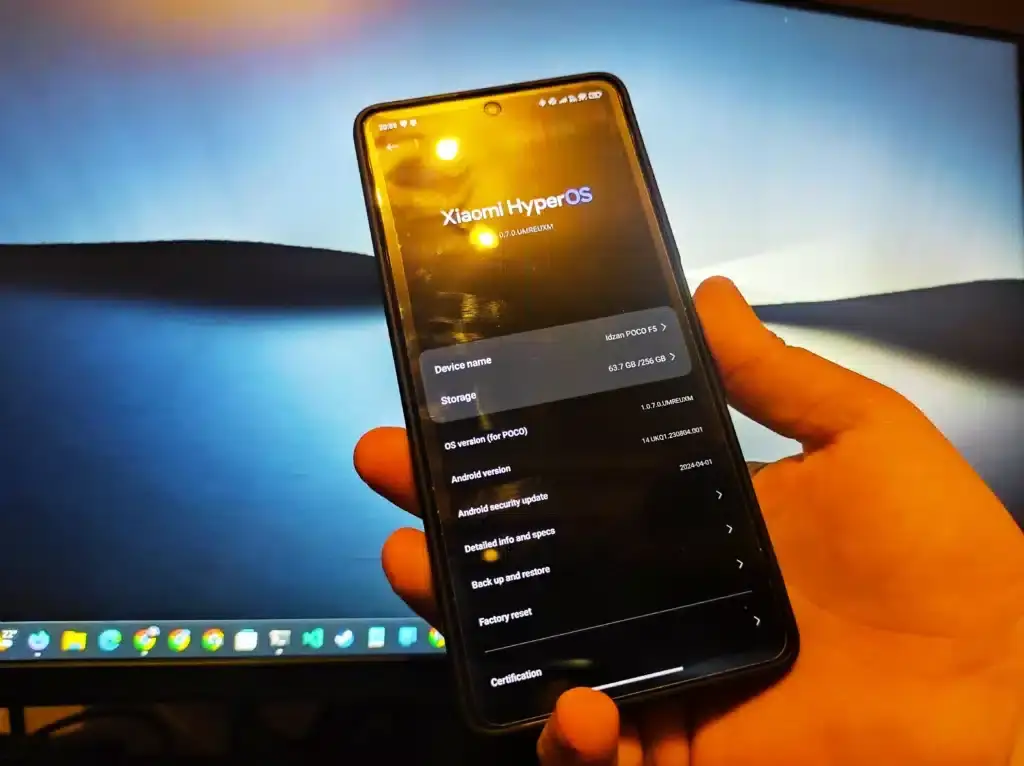So, this is something special in my mind, as this is my current review after 6 months of using Xiaomi’s solid midrange device. The hardware is impressive, especially for the price, which is “nice”.
Another note: I started writing this post a month and a half after using the Poco F5 on the same phone, but later, as I explored other options and drafted other posts, I’m finishing this on my new tablet with a basic wired keyboard connected through an OTG dongle.
Now, let’s start with an option: Why choose the Poco F5 when you had other options around the 500 Euro price point for a brand new phone? You could have switched brands, but Xiaomi offers the best value at that price. I could have upgraded to the Poco F5 Pro, but it was out of my budget as it was priced around 620 Euros on the day I purchased the Poco F5. I also considered other models like the Honor 90, Motorola Edge 40 (256GB version), and even the Samsung Galaxy A54 in the 256GB variant. I chose the Poco F5 because it seemed like the best option to last me the next 3 years.
Here are some quick specifications of the phone I bought: Snapdragon 7+ Gen2 SoC, 12GB of RAM, 256GB of storage, Bluetooth 5.3, a 5000mAh battery with 67W wired charging, an AMOLED screen, and 5G compatibility. It also supports WiFi 6, as my new ISP-provided router does. More detailed specifications can be found on the Poco official site.
The phone arrived with great packaging that included not only the phone, SIM eject tool, and some paperwork but also a clear TPU phone case and a charging brick with a cable. Even with this packaging, the device felt premium even before I moved the SIM card to the phone. The back of the phone is plastic but looks like glass, which is great. On the black model, you can’t see any smearing or dust. Plus, it came with a pre-applied screen protector from Xiaomi.
A major highlight is that the phone came with MIUI 14 and Android 13, and within the first month, I received an early beta HyperOS update with Android 14. This was a fast update for us Xiaomi Pilot testers who use almost every beta update for the OS. I won’t mention the short MIUI usage as it closely resembles HyperOS, which is lighter and easier on RAM usage. Otherwise, the interface is similar.
Now, to the meat and potatoes of the review: how it is to use the phone – it’s perfection. No issues so far within these 6 months. The fluidity of the 120Hz AMOLED HDR+ display is a step up from the old 60Hz IPS display of Xiaomi’s Redmi Note 9 Pro. Both displays are HDR compatible and can easily showcase HDR content on YouTube. The fingerprint sensor on the right edge in the power button is very convenient. With a simple touch to the power button, the phone is unlocked. With a double tap, I can quickly turn on the flashlight, a handy feature in dark places. And don’t forget – a classic double click on the power button opens the camera application.
The camera, a 64MP unit with 4K video recording, is impressive. Even with basic auto settings, the camera images are great. There’s no comparison with the Redmi Note 9 Pro as the camera sensors are completely different, providing superior night mode capabilities. I’ve tested it even with Pro Mode, which enables all sorts of camera tricks like White Balance, Focusing, ISO Exposure, and other DSLR-like features. 4K video recording is still at 30FPS, which is just fine for me, but others might want to have 4K at 60FPS, which can be achieved with a GCam mod not available in the official camera, but honestly, I really don’t care.
Camera shot examples are in the Gallery, while video examples can be found on a YouTube playlist created just for this review. It includes various situations from darker home environments to standard daily usage. And yes, almost forgot, there is OIS in the main camera, but I didn’t test it as most shots are from a moving camera (slow panning), where OIS might show its effectiveness.
For battery life, I’ll say one thing – it can survive 2 days easily even with 6+ hours of screen on time, which includes watching videos on YouTube, using the camera, and even GPS navigation, always on WiFi, 5G/LTE depending on location. With 67W charging, I can say confidently that my phone, from about 10% battery, can be charged to 100% within 40 minutes. At worst, the phone endured one day of heavier usage, almost 8 hours of screen on time with GPS navigation, switching between 4G and 5G, music playback, and some photography on location.
In conclusion, this phone is perfect. There’s even a vibrant unofficial custom ROM community plus official support for the next 3 years, which will include at least one more major Android update (from 14 to 15) and 2 more major HyperOS updates, hopefully on Android 14 and later on Android 15. Replacement phone cases and screen protectors can be found on AliExpress, Temu, and other sites. That’s where I bought one fake leather type case, one wallet type case, and another black classic TPU case.
The review was written on multiple devices, including Poco F5, my new Blackview Oscal Pad 10 tablet, and even a PC for some parts. Photos and videos are my own creations made with Poco F5 and Redmi Note 9 Pro, especially the cover image, which was shot on the old Redmi phone.
This text was proofread with the assistance of ChatGPT 4.0 model.
